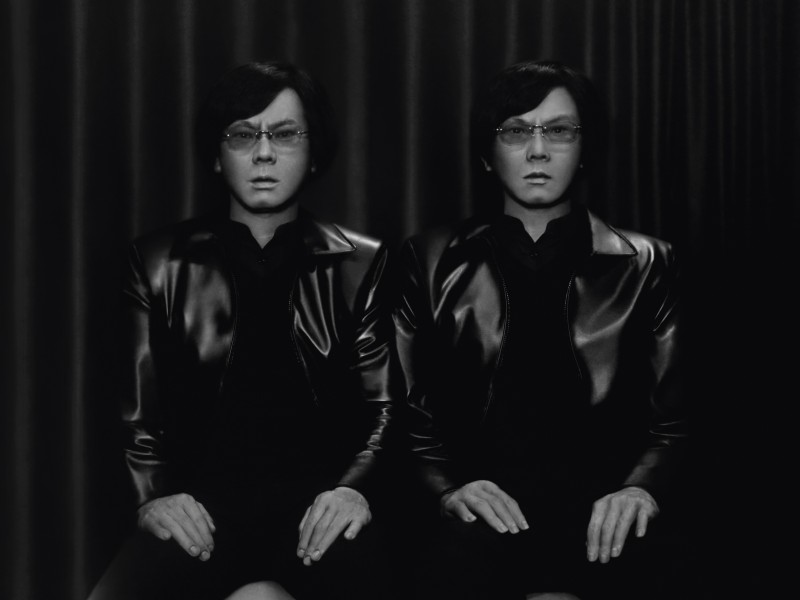In this nicotine-stained café, once the preserve of market workers and late-night hustlers, there are black boys with pink hair talking fashion to white girls with Afros. “She’s beyond amazing,” declares a wild-eyed youth describing his latest discovery. “It’s like Lang on acid—sick and beautiful and completely NOW!” Beyond this scenario, lurking in the corner, sits legendary American photographer Annie Leibovitz—chic and understated, but surveying the room with a frosty antipathy. Paris Fashion Week is in full flow, and people are watching.
Into the melee—and turning heads—walks the South Korean fashion designer known as Kaimin. She totters slightly on elevated, paint-splattered wedges and plays with her long blonde hair, but it’s the outfit that draws most attention. What is she wearing? Plucked straight from her Spring/Summer 2018 collection this is PR at its most effective—a standout piece modelled by the designer herself. She is Uma Thurman in Kill Bill by way of Deee-Lite’s Lady Miss Kier, squeezed into a bipolar creation that is half Formula One biker jacket, half bondage couture. Turn her to the left and she is a leather-clad racer; twist her around and the effect is restrictive, dominant and luxuriously risqué.
“I like the duality,” she says, ordering white wine. “It’s a yin and yang thing. I like extremes.”
Her heady Serge Lutens perfume speaks volumes. Not for the fainthearted, it’s a headstrong scent that signals both business and pleasure, yet floral top-notes suggest a romantic soul too. She is playful and sexy, endearingly friendly, and carries the whole Manga biker look incredibly well. But who is this Asian enigma inviting curious glances, and what do her outré, theatrical clothes say about her?
Kaimin was born “sometime” in the late 1980s (“I’m the right side of thirty”) in South Korea, where she forged a creative path from a young age. She is eager not to dwell on the past (off the record there have been stints as a successful stylist, artist and producer of ideas) but is happy enough to reflect on her upbringing. “In Asia, deviation from the norm is rare and is almost frowned upon,” she says. “I always felt the need to be different and to break out of the mould. I think this shaped my aesthetic and fuelled my curiosity.”
A fortuitous meeting with the lauded video artist Nam June Paik moved her into interesting territory. She became his protégé and got a taste for discordance directing the documentary, From the Fall of Berlin Wall to the DMZ, which ultimately became the auteur’s final multimedia project. “Nam was a true visionary,” she says, “he coined the term ‘information superhighway’ in the mid-seventies, and I think I inherited some of his reluctance to be pigeonholed. He pretty much opened my eyes to the possibilities of art.” Paik once said, ‘Our life is half natural and half technological. Half-and-half is good.’ Which makes perfect sense when you see his student’s clothes. “I very much agree,” she says, “and I seek to embrace technology in everything I do—from the production of my campaigns to the innovative, high-tech materials I employ in my clothing”.
Now a fully formed fashion designer based in New York, and just three seasons into a career, the role seems a natural fit. “I love to transform myself into someone else. Clothes really are the easiest way to do this, to alter your own perception from within and to completely change the way others perceive you.”
Describing today’s outfit, Kaimin is assured and directional. “I’m combining my signature bondage and punk elements with an exceedingly vibrant colour scheme and innovative materials to present a vision of the future. It’s where gender boundaries are intentionally de-emphasised and the wearer is empowered by the unapologetic comfort with their sexuality without the clothes appearing vulgar.” It’s a bit of a mouthful but Kaimin, or just ‘Kai’ to her friends, draws you into her Technicolor world with all the breathless seduction of a futuristic Bond Girl.
“My new collection is titled Slut From The Future,” she declares, “and I think that name describes my overall creative bias. I’ve always been fascinated by technology and the image of the future, so for my work I purposefully seek out cool new materials you just don’t see every day, like the iridescent PVC I use, or the ‘liquid’ fabric that looks like it’s melting. And of course I’m infatuated with sexuality and seek to emphasise the human body in my designs with varying degrees of subtlety. I also try not to take things too seriously, thus the cheeky name, juxtaposed with the overall serious visuals of the campaign … and obviously, anyone can be my slut—a girl or a boy.”
She is smiling but this moots a valid point. Alongside a handful of other designers, including Palomo Spain, the Kaimin brand is noted for its gender neutrality. These might look like futuristic sex clothes for ramped-up disco dollies, but that doesn’t mean anyone—of any identity—can’t slip between the latex and get into the groove. “I’m very comfortable with evolution, or so-called taboos,” she says. “Gender clearly has never been black and white and the pre-existing definitions are becoming less and less inclusive. I think it’s unnecessary to categorise everything and I wish all people were comfortable with this. I don’t have a set gender target in mind, and the clothes I create can be interpreted in so many ways that they tend to appeal to people from across the board. I’m all for that.”
Related Features
-
211
-
-
-

